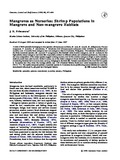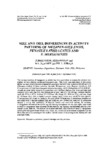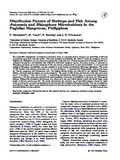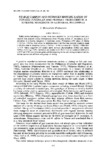Mangroves as nurseries: Shrimp populations in mangrove and non-mangrove habitats

View/
Request this document
Date
1998Author
Page views
288Metadata
Show full item recordCited times in Scopus
Share
Abstract
A total of 4845 penaeids belonging to nine species—Metapenaeus anchistus, M. ensis, M. moyebi, M. philippinensis, Penaeus merguiensis, P. monodon, P. semisulcatus, P. latisulcatus and Metapenaeopsis palmensis—were collected by pocket seine monthly over 13 months from mangrove and non-mangrove sites in Guimaras, Philippines. The restricted distribution of the three dominant species—M. ensisandP. merguiensisto the brackish water riverine mangrove, andM. anchistusto the high-salinity island mangrove and tidal flat—is probably related to different salinity and substrate preferences. Abundance and size composition of the major species suggest a strong nursery role for the riverine mangrove (high juvenile densities, relatively small sizes year-round), limited nursery use of the island mangrove (fewer shrimps, larger size ranges, presence of maturing females) and a non-nursery use (e.g. foraging) in the tidal flat. Penaeid recruitment to the river had two peaks in November and May when the average salinity was ∼20 (Practical Salinity Scale) and water temperatures were high (30–31 °C). The spatio-temporal pattern of penaeid species in Guimaras shows partitioning across habitats and seasonal recruitment influenced by physical and biological factors.
Keywords
penaeids prawns recruitment juveniles estuary PhilippinesSuggested Citation
Primavera, J. H. (1998). Mangroves as nurseries: Shrimp populations in mangrove and non-mangrove habitats. Estuarine, Coastal and Shelf Science , 46(3), 457-464. https://doi.org/10.1006/ecss.1997.0275
Subject
nursery grounds  ; abundance
; abundance  ; mangrove swamps
; mangrove swamps  ; salinity
; salinity  ; breeding sites
; breeding sites  ; tidal flats
; tidal flats  ; substrates
; substrates  ; biological sampling
; biological sampling  ; marine crustaceans
; marine crustaceans  ; size distribution
; size distribution  ; mangroves
; mangroves  ; habitats
; habitats  ; shrimp
; shrimp  ; spatial distribution
; spatial distribution  ; Penaeus monodon
; Penaeus monodon  ; Metapenaeus
; Metapenaeus  ; Metapenaeus anchistus
; Metapenaeus anchistus  ; Penaeus semisulcatus
; Penaeus semisulcatus  ; Penaeus latisulcatus
; Penaeus latisulcatus  ; Metapenaeus moyebi
; Metapenaeus moyebi  ; Metapenaeus ensis
; Metapenaeus ensis  ; Penaeus merguiensis
; Penaeus merguiensis  ; Penaeus
; Penaeus  ; Panay
; Panay  ; Guimaras
; Guimaras  ; Philippines
; Philippines 
 ; abundance
; abundance  ; mangrove swamps
; mangrove swamps  ; salinity
; salinity  ; breeding sites
; breeding sites  ; tidal flats
; tidal flats  ; substrates
; substrates  ; biological sampling
; biological sampling  ; marine crustaceans
; marine crustaceans  ; size distribution
; size distribution  ; mangroves
; mangroves  ; habitats
; habitats  ; shrimp
; shrimp  ; spatial distribution
; spatial distribution  ; Penaeus monodon
; Penaeus monodon  ; Metapenaeus
; Metapenaeus  ; Metapenaeus anchistus
; Metapenaeus anchistus  ; Penaeus semisulcatus
; Penaeus semisulcatus  ; Penaeus latisulcatus
; Penaeus latisulcatus  ; Metapenaeus moyebi
; Metapenaeus moyebi  ; Metapenaeus ensis
; Metapenaeus ensis  ; Penaeus merguiensis
; Penaeus merguiensis  ; Penaeus
; Penaeus  ; Panay
; Panay  ; Guimaras
; Guimaras  ; Philippines
; Philippines 
Taxonomic term
Collections
- AQD Journal Articles [1218]
Related items
Showing items related by title, author, creator and subject.
-
Size and diel differences in activity patterns of Metapenaeus ensis, Penaeus latisulcatus and P. merguiensis
Primavera, Jurgenne; Lebata, Ma. Junemie Hazel L. (Taylor & Francis, 2000)The nursery function of mangroves as shelter has been postulated to explain the positive correlation between shrimp catches and mangrove area. This study was undertaken to document shelter use and other activities in ... -
Distribution pattern of shrimps and fish among Avicennia and Rhizophora microhabitats in the Pagbilao mangroves, Philippines
Rönnbäck, Patrik; Troell, M.; Kautsky, N.; Primavera, Jurgenne (Elsevier, 1999)For sustainable management of mangrove ecosystems, there is a pressing need to increase our knowledge of fish and invertebrates associated with this system. This study sampled microhabitats (89–258 m2) ... -
Stable carbon and nitrogen isotope ratios of penaeid juveniles and primary producers in a riverine mangrove in Guimaras, Philippines
Primavera, Jurgenne (University of Miami, Rosenstiel School of Marine and Atmospheric Science, 1996)Stable carbon and nitrogen isotope ratios were analyzed for primary producers and juveniles of four penaeid species (Metapenaeus ensis, Penaeus indicus, P. merquiensi and P. monodon) in a riverine mangrove in Guimaras, ...




